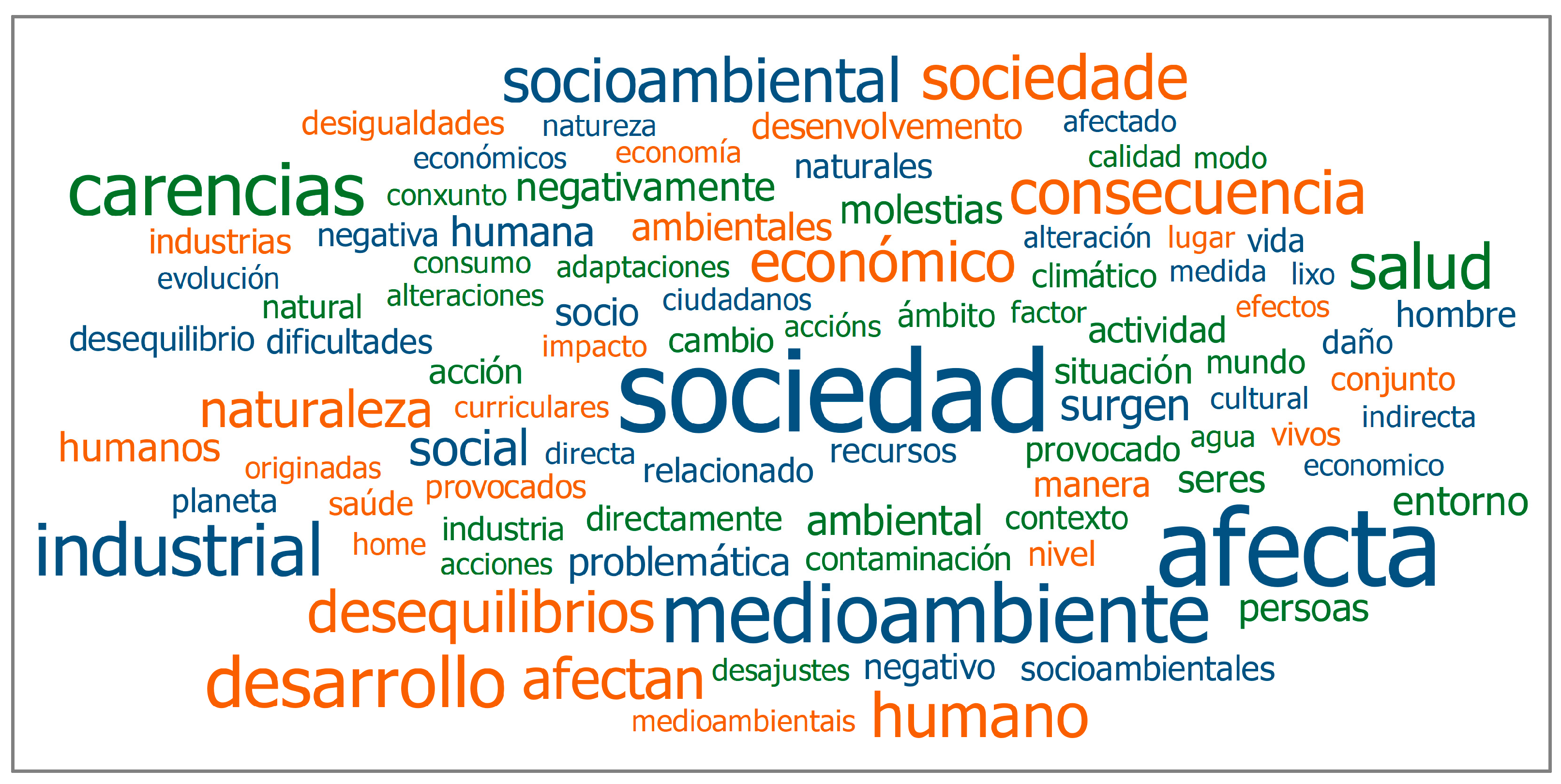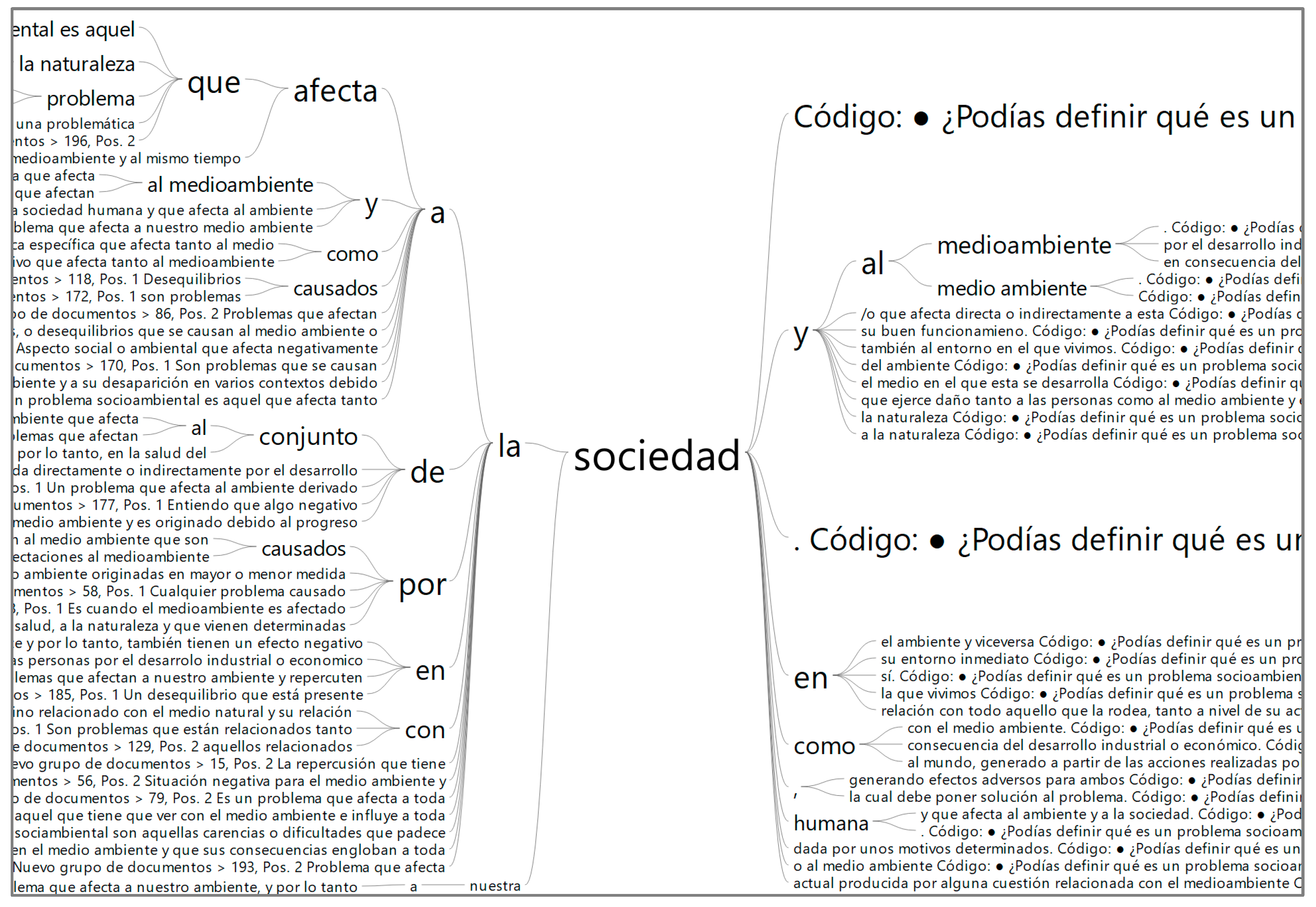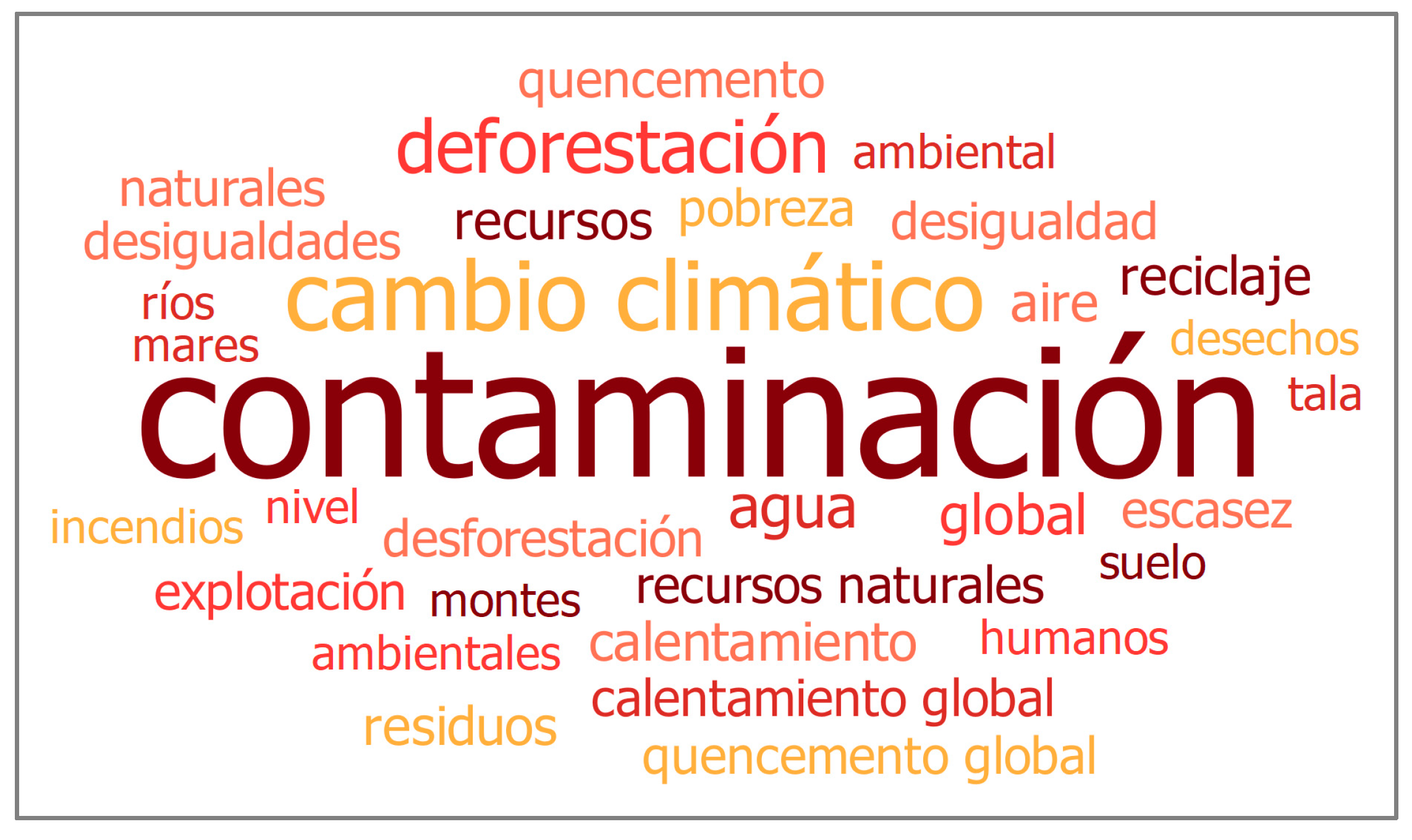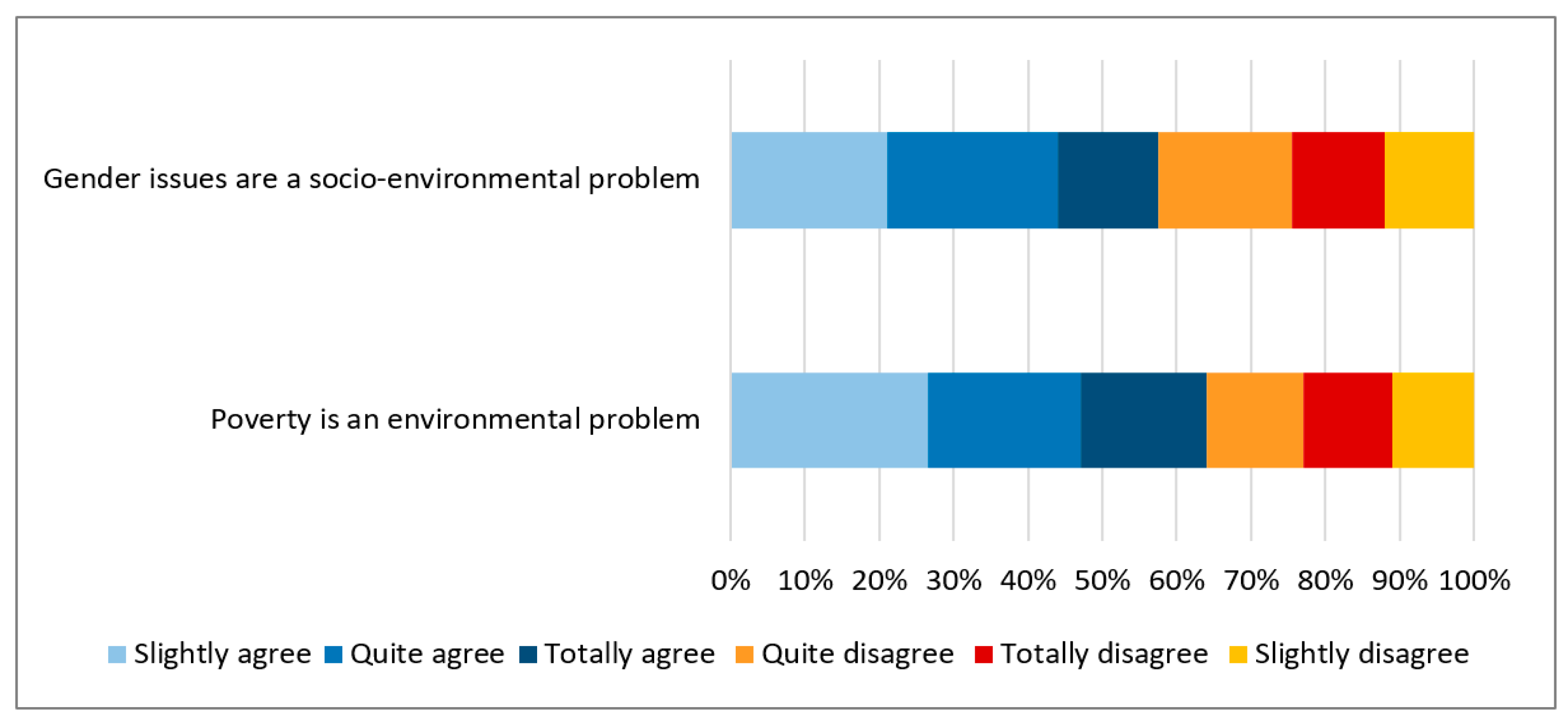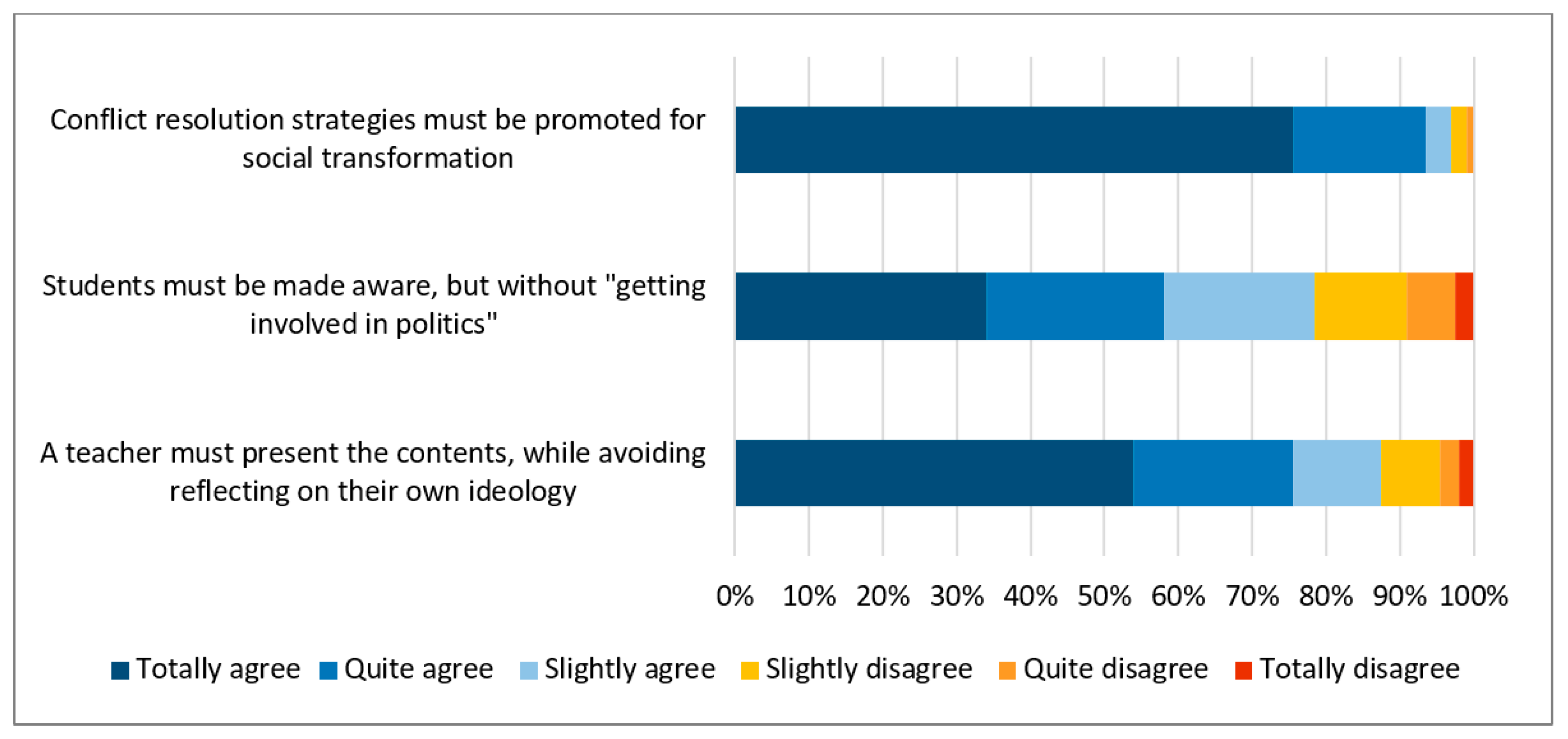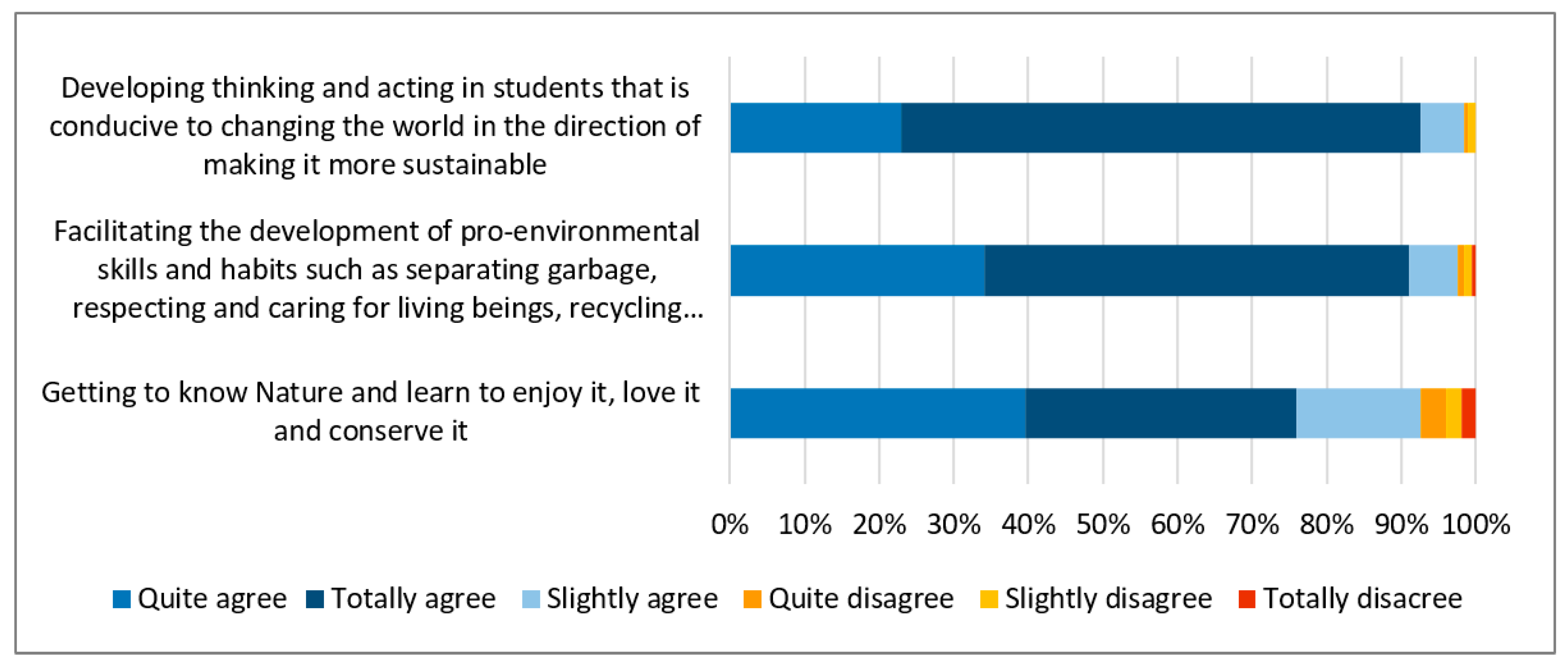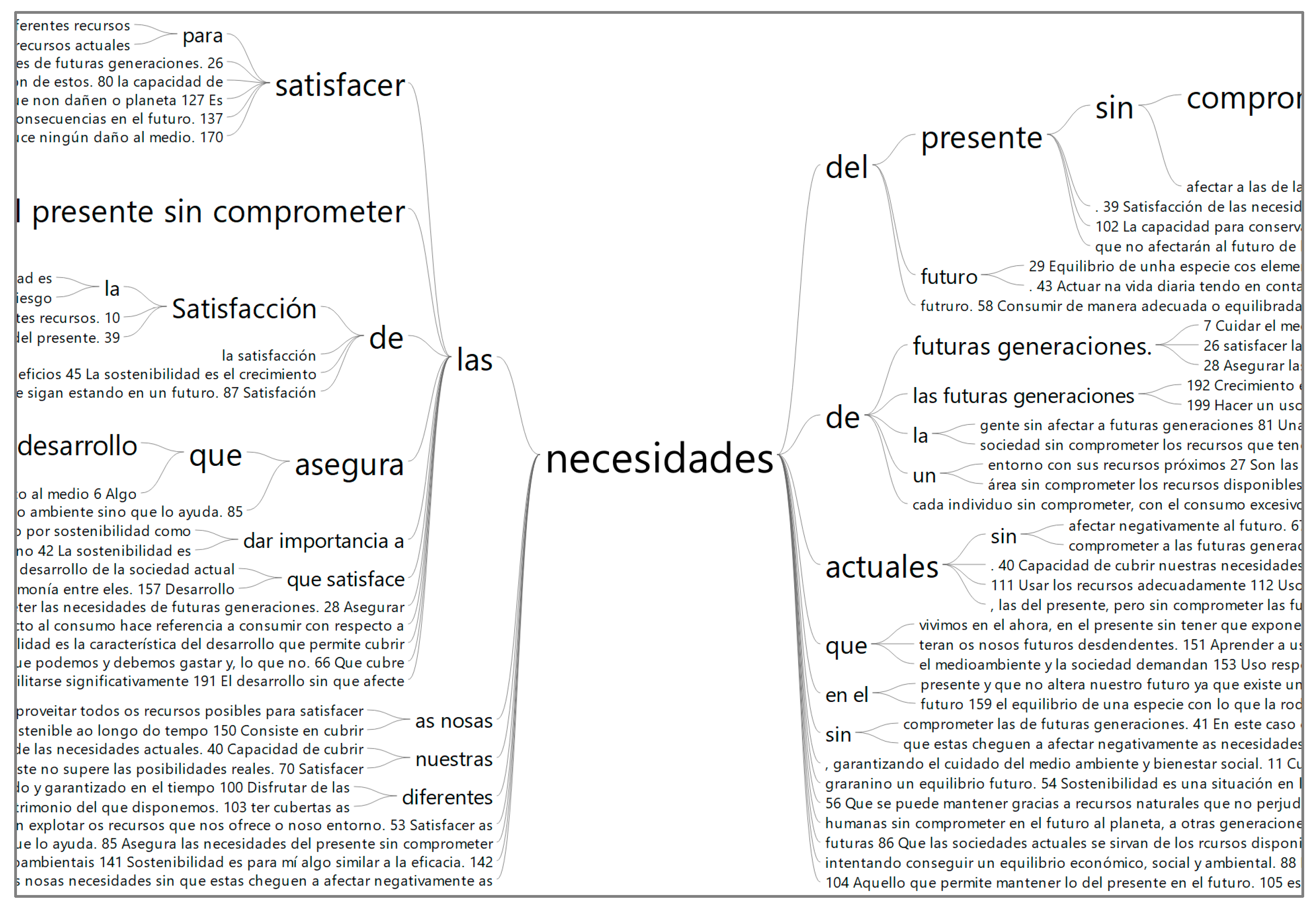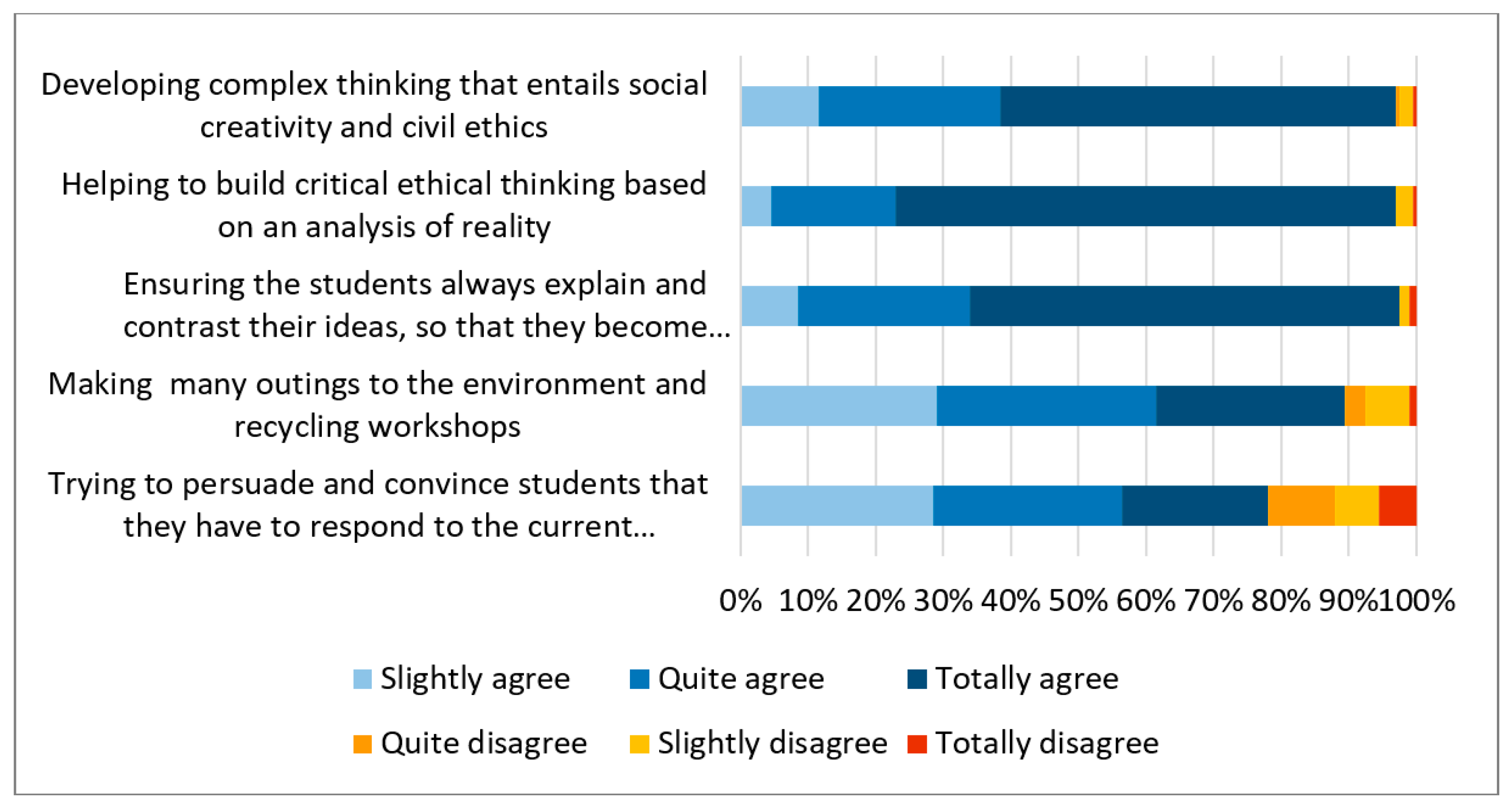1. Introduction
Today, society is facing a myriad of highly complex problems, health crises, armed conflicts, media wars, and geopolitical tensions, just to mention a few. Teachers face a great challenge, that of preparing students in the development of skills that enable them to face these problems and make decisions aimed at seeking a more sustainable society. For this, it is essential that schools adopt a holistic approach to problems that allows for the formation of a critical global citizenship (
González et al. 2020) that is based on the understanding of the multiple dimensions involved: social, cultural, economic, philosophical, political, climatic, territorial, etc. For example, although problems such as climate change or the depletion of non-renewable resources are worked on in schools, it is not easy for them to relate to production, distribution, and consumption models (
González Reyes and Rodríguez 2020). However, problems such as gender violence, racism, or poverty, in a major way, are attributed to social problems without a connection to environmental dynamics (
Massip et al. 2021).
This disjointed approach between the disciplines hinders the effective resolution of problems, since, although of different natures, they are closely linked. In this way, a problem such as climate change or extreme poverty cannot be solved without considering its link to other problems, such as the irresponsible consumption of goods and services. In this sense, the science of sustainability constitutes a backbone, an approach that permeates all disciplines (
Vilches and Gil 2021). Nevertheless, education for sustainability still needs a collective reflection on these problems that avoids a biased and reductionist treatment (
Barrón et al. 2010).
In the training of future Social Sciences teachers, the introduction of this interdisciplinary teaching is essential. However, previous studies show that the degree of knowledge of future teachers about socio-environmental problems is limited (
Zamora-Polo et al. 2019), meaning that they are unable to train competent citizens set to face the challenges of this century (
Moreno-Crespo and Moreno-Fernández 2015). Therefore, the areas of Social Studies Teaching and Experimental Sciences Teaching at universities must consider a joint approach to current problems (
Massip et al. 2021;
Alcántara-Manzanares and López-Fernández 2021).
For Social Sciences teaching to be oriented toward a holistic teaching–learning process, it is essential to analyze the social representations of students (
Santisteban 2009;
Pagès and Santisteban 2014). Hence, the present work aimed to investigate the social representations that future primary school teachers have about socio-environmental problems, sustainability, the purposes of socio-environmental education, and the strategies to train in Global Citizenship Education and in Education for Sustainable Development. The purpose of this study was that the authors, teachers in the area of Social Sciences Teaching, can introduce improvements in these subjects in the Degrees of Primary Education at two public universities in the University System of the Autonomous Community of Galicia (Spain), namely the University of A Coruña and the University of Santiago de Compostela.
1.1. A Holistic Approach of Social Sciences Teaching
In the scientific literature on Social Studies Teaching, there seems to be a consensus regarding the need to work in the classroom with real, current, complex, controversial problems that encourage students to reflect and take social action. In this sense, a group of terms have been consolidated to refer to these relevant issues that should be part of the curriculum. The term
issues-centered social studies was introduced in the work of
Evans and Saxe (
1996), which had a great impact on critical social studies. In the Spanish context, it was translated as
problemas sociales relevantes (socially relevant problems) (
Pagès 1994;
Benejam 1997;
Santisteban 2004,
2011,
2019), while in the Francophone context, the term
questions socialement vives (socially relevant issues) emerged (
Legardez 2004;
Legardez and Simonneaux 2006). Likewise, the term
controversial issues has been used (
Eulie 1966;
Wellington 1986;
Hess 2008) as an essential element of education and democracy for the formation of critical thinking (
Santisteban 2017).
Similarly, the term
environmental problems has gained prominence in the face of the progressive worsening of problems such as climate change, resource exploitation, water pollution, etc. There is no doubt that the relationships between causes and consequences linked to both social and environmental dimensions can be established in these problems. In this way, it is no longer possible to speak of any environmental problem that does not originate from human action in the biosphere, nor of any social problem that is not related, to a lesser or greater extent, to the management of natural resources and its needs (
Massip et al. 2021). In fact, if we understood the environment as a complex system of interrelationships between all its parts, including human beings (
Martínez-Medina and Torres-Porras 2021), the term
environmental would already include the social component.
To avoid falling into the error of treating environmental problems only from their ecological dimension, some authors propose terms such as
socio-environmental problems (
Amador and Esteban 2011;
Moreno-Crespo and Moreno-Fernández 2015;
Ortega-Sánchez et al. 2020;
Rodríguez-Marín et al. 2020;
Bonilla and Garzón 2021;
Martínez-Medina and Torres-Porras 2021;
Massip et al. 2021) or
eco-social problems (
González Reyes and Rodríguez 2020;
Santana et al. 2021). Apart from this terminological debate, Social Sciences teaching must contribute to a holistic approach to the problems of today’s society. This need has recently been reflected in Spain, as a result of the new education law. In this way, Royal Decree 157/2022, of 1 March, which establishes the organization and minimum teachings of Primary Education, indicates that “the link between key competences and challenges of the 21st century is what will give meaning to learning, by bringing the school closer to real situations, issues and problems of everyday life” (
Boletín Oficial del Estado 2022, p. 24402). Likewise, this Royal Decree establishes that these challenges require the following:
Require transcending the local perspective to analyse and also commit to global problems. All this requires, on the one hand, a complex mind, capable of thinking in systemic, open terms and with a high level of uncertainty, and, on the other, the ability to empathise with relevant aspects, even if they do not affect us directly, which implies assuming the values of social justice, equity and democracy, as well as developing a critical and proactive spirit towards situations of injustice, inequality and exclusion.
In this educational process based on the problems of today’s society, in its understanding and intervention in the search for social and environmental justice, Education for Sustainable Development constitutes a fundamental pillar. Thus, the
Goal 4 Quality Education of the Sustainable Development Goals (SDG) of the 2030 Agenda of the United Nations Organization, in its goal 4.7, establishes the following:
By 2030, ensure that all learners acquire the knowledge and skills needed to promote sustainable development, including, among others, through education for sustainable development and sustainable lifestyles, human rights, gender equality, promotion of a culture of peace and non-violence, global citizenship and appreciation of cultural diversity and of culture’s contribution to sustainable development.
Achieving these goals set out in the new educational legislation and in the SDGs depends, to a large extent, on the ability of acting teachers to concretize the curriculum (
Moya and Zubillaga del Río 2020) and on the training of future teachers. Regarding the latter, some recent works show that there is still a long way to go. This is the case of the study by
López-Fernández and Oller (
2019), who show that the didactic proposals on environmental education designed by future primary school teachers show little concreteness in relation to reality. These focus on the development of habits such as recycling, reusing, and reducing, without questioning the current model of consumerist and capitalist society (
Stiglitz 2015). In addition, the conceptual knowledge they had about the environment and the problems generated, directly and indirectly, by society was quite ambiguous.
1.2. Social Representations of Teachers in Initial Training
Professional training should start from the investigation of social representations on the role of the teacher and on the teaching of social disciplines. In this way, students have a starting point to become aware of the rationality that hides behind their social representations, so that they can assess it and, based on the results, choose to modify or maintain it (
Pagès and Santisteban 2014).
Social representations are specific ways of understanding and communicating reality that influence the form of social interaction as they evolve. They represent the concepts, statements, and explanations that originate in everyday life during interpersonal communications (
Moscovici 2011). The notion of representation interrelates the psychological and social approach, laying the foundations for the creation of knowledge, based on personal experiences and the influence received from society (
Jodelet 1989). Therefore, knowledge can be built from the rupture of initial representations through a process consisting of the following stages (
Dalongeville 2003): emergence of representations and awareness; confrontation with a situation/problem that calls the representations into question; reconstruction of new representations that reorganize the old ones and integrate the new ones; and metacognition of the processes that the subject, individually and in a group, has put into practice.
However, as appreciated in this literature review, more interdisciplinary teaching is needed to train future Social Sciences teachers from a holistic approach. This means that educational practice and research must be oriented to train competent citizens to understand the complexity of 21st century challenges. For this, it is essential that the problems of today’s society be analyzed in classes, from different perspectives, to help students to develop critical thinking. In this process, analyzing student teachers’ social representations is crucial to direct teaching–learning toward the construction of significant knowledge and constant improvement of teaching practice.
2. Materials and Methods
This work is framed in an action-research approach, understanding it as a self-reflection on the actions and social situations experienced by teachers, which allows them to identify their practical problems and direct actions to solve them (
Elliott 2000). Action-research is constituted as a critical science that allows improved rationality and justice: of social or educational practices, of the understanding of the participants (teachers, students, directors, etc.) about it, and of the social situation in which it takes place (classrooms, schools, etc.) (
Kemmis and McTaggart 1988). Specifically, an exploratory case study (
Yin 1989) is carried out through inductive reasoning, allowing for the discovery of relationships and concepts in the context under study, contrasting them with others and designing an action strategy for change (
Muñoz and Muñoz 2001;
Bisquerra 2009).
The study is framed in the Autonomous Community of Galicia, which has the highest density of forest masses in Spain, but, at the same time, the least protected by Natura 2000, the European network of protected areas. In this sense, knowing the students’ perception of Nature, society, and sustainability seemed very appropriate. This research is a continuity of previous collaborations between teachers from the area of Social Studies Teaching of two public universities in the Autonomous Community of Galicia (Spain): the University of A Coruña and the University of Santiago de Compostela. They are two out of three public universities that exist in Galicia, where students from practically all Galicia study the Primary Education Degree. Thus, this sample covers an important part of the study region.
The purpose of this research is to guide teaching practice toward the training of future primary school teachers who are competent and committed to achieving a more sustainable society. Therefore, the study was carried out from a convenience sample of 200 students in the second and third years of the Primary Education Degree from both universities.
Students from the University of Santiago de Compostela made up 70% of the sample, of which 60% were in the second year and 40% in the third. The students from the University of A Coruña, comprising 30% of the whole sample, were all in their third year. The average age of the students was 21 years. By age ranges, the distribution was as follows: 78.5% between 19 and 21 years old, 14.5% between 22 and 24 years old, 3.5% between 25 and 27 years old, 1.5% between 28 and 30 years old, and 2% were over 30 years old. In relation to gender, 66.5% identified themselves as female, 32.5% as male, and 2% as non-binary.
To investigate the social representations of future primary school teachers, a questionnaire was used as an instrument for collecting information. The one proposed by
Solís-Espallargas and Valderrama-Hernández (
2015) was adapted, since it is a validated instrument that includes an important part of the questions that are the object of this study. In addition, this questionnaire has been used by other authors (
Ortega-Sánchez et al. 2020), allowing the results of this research to be compared with previous studies on this subject.
To respond to the objectives of this research, the questionnaire was structured in three parts: (1) social representations about socio-environmental problems, (2) social representations about socio-environmental education and Education for Global Citizenship, and (3) social representations on sustainability and Education for Sustainable Development. The adaptations to the questionnaire (
Solís-Espallargas and Valderrama-Hernández 2015), which are explained below, made possible a qualitative and quantitative analysis of the data. Thus, it was made up of twelve questions, four in part 1 of the questionnaire, two in each of the parts 2 and 3, and four in the personal information part. Of these, four closed nominal questions with a single answer collected the information on the students’ profile (university of study, grade, age, and gender), allowing an inferential analysis to know if they present any causal relationship with the research issues. Moreover, in this same question, typology students were also asked whether they had received training on socio-environmental topics during the degree or not.
Likewise, the scale of the three metric questions was modified. The central value was eliminated, since it was considered that the term
tending to agree does not reflect a clear positioning of the respondent. Therefore, to better qualify the answers, the scale was made up of the following categories: totally disagree, quite disagree, slightly disagree, slightly agree, quite agree, and totally agree. Each of the metric questions encompasses several topics that can be seen in the text and graphics of
Section 3. Finally, for the qualitative analysis, four open-ended questions allowed the following to be known: the subjects in which the students had training in socio-environmental problems during the degree, their capacity to define what a socio-environmental problem is, their priorities of socio-environmental problems to work on in a primary school class, and what they understand as sustainability.
To check the reliability and internal consistency of the questionnaire items, the Cronbach Alpha values were calculated through MAXQDA, a program that also allowed for the quantitative and qualitative analysis of all the research data. To calculate the Cronbach Alpha values, the questions were grouped into two groups. The first was related to the questions that investigated the degree of knowledge about socio-environmental problems and sustainability, yielding a value of 0.8. The second grouped the questions about the role of education and the strategies that teachers should follow, also obtaining a value of 0.8. Therefore, the questionnaire items have good consistency, as indicated by
Oviedo and Campo-Arias (
2005) for Cronbach Alpha values between 0.7 and 0.9.
The questionnaire was designed by using Microsoft Forms and was applied to the students of the University of Santiago de Compostela December 2021 and to those of the University of A Coruña in March 2022. In addition, it is important to point out that, although the questionnaire was in Spanish, some students responded in Galician, the co-official language in Galicia. This was taken into account when performing the statistical processing, so that similar responses in both languages were counted. All data were treated anonymously, and their use is limited to research purposes and to make improvements in this area of knowledge.
From the point of view of the methodological limitations of this study, it should be mentioned that, although the questionnaire includes open questions, the use of other research instruments, such as interviews or discussion groups, could have further enriched the results. Likewise, as it is a case study, the results must be understood in the context in which it has been developed; therefore, it cannot be generalized. However, they can be contrasted with other cases to find similarities and differences that contribute with knowledge to the area.
3. Results
This section presents the research results grouped into three subsections: (1) social representations of socio-environmental problems, (2) social representations of socio-environmental education and Education for Global Citizenship, and (3) social representations of sustainability and Education for Sustainable Development. Some textual responses from the students were included in the results, being identified by an A, together with the number assigned by the MAXQDA program for each response.
3.1. Social Representations about Socio-Environmental Problems
To begin with, the students had to indicate if they had received training in socio-environmental problems during their degree. A total of 60.5% indicated that they had not received training on this subject, while 39.5% indicated yes, fundamentally in the subjects of the area of Social Studies Teaching, as indicated by 72% of the students, and in those of Natural Sciences Teaching, as mentioned by 23% of the students.
Next, students were asked to define the concept of a socio-environmental problem. As
Figure 1 shows, which includes the 100 most mentioned words, the term
sociedad (society) was the most relevant, being mentioned by 26.5% of the students. To this we must add those who responded in Galician, indicating
sociedade, representing 10%. The second most mentioned term was
afecta (affects), as indicated by 24.5%, to which we must add other related terms, such as
afectan (affect),
afectado (affected), and
afectaciones (affectations), which represent 4%. In third place, the term
medioambiente (environment) appears, as mentioned by 17% of the students.
The word tree in
Figure 2, centered on the most mentioned word,
sociedad (society), shows two types of relationship that students establish between it and the
medioambiente (environment). On the one hand, they indicate that both society and the environment are victims of socio-environmental problems since both suffer from its negative effects. It can clearly be seen in the figure how the word
afecta (affects) unites both terms, being able to read “que afecta a la sociedad y al medioambiente” (that affects society and the environment). In this way, some definitions of socio-environmental problems were “a specific casuistry that affects both the environment and society, generating adverse effects for both” (A33) or “events that negatively affect the environment and, therefore, also have a negative effect on society” (A6). Likewise, the concern about the negative impact on health stands out, with the term
salud (health) being mentioned by 11% of the students.
On the other hand, society is recognized by the students as the cause of these effects on the environment. Some statements in this regard are as follows: “difficulties in the environment caused to a greater or lesser extent by society” (A2), “problem generated by a society in its immediate environment” (A35), or “problems at the environmental level that are caused by the consumerist society in which we live” (A129). Likewise,
Figure 1 shows recurring terms, such as
económico/s (economic),
industrial (industrial),
industria (industry), or
desarrollo (development) to refer to the factors causing socio-environmental problems. Some examples are the following definitions: “imbalances caused to the environment and/or the health of people that arise as a consequence of industrial or economic development” (A26), or “they are deficiencies or inconveniences to the environment produced by industrial and economic development” (A29).
It is striking that the students show their concern about the negative impact on society and the fact that it is society itself that causes it, but not about the fact that society is the only one that can solve these problems. In this sense, only one response was recorded: “it is a problem that affects our environment, and therefore our society, which must solve the problem” (A66). Likewise, there were eight students who were not able to define what a socio-environmental problem was, of which seven were second-year students at the University of Santiago de Compostela.
Figure 3 shows the most recurrent terms when the students proposed a socio-environmental problem to work on in a primary education classroom. As can be seen,
contaminación (pollution) was the most mentioned, being proposed by 41.5% of the students, followed by
cambio climático (climate change), as indicated by 32%. Other problems mentioned to a lesser extent were deforestation (11%), global warming (5%), and concern about water (5%) in regard to its contamination, as well as its consumption.
It should be noted that problems such as social inequalities or poverty had very little presence: 3.5% and 2%, respectively. Precisely, 36% of students disagreed with the fact that poverty is an environmental problem. Of these, 25% totally disagreed or quite disagreed. As can be seen in the graph in
Figure 4, only 17% totally agreed that poverty is an environmental problem. Likewise, it can be seen how gender issues are not perceived as a socio-environmental problem by 42.5% of the students, with only 13.5% totally agreeing with it.
3.2. Social Representations on Education for Global Citizenship and Socio-Environmental Education
There is a consensus among the students regarding the need to promote conflict resolution strategies to achieve social transformation. Thus, this idea is supported by 97% of the students, of which 75.5% totally agreed (
Figure 5). However, 78.5% of future primary school teachers consider that it is inappropriate to work on political content in class. The remaining 22.5% disagreed; however, only 9% of them totally or quite disagreed. Likewise, 87.5% of the students consider that teachers should present the contents, while avoiding reflecting on their own ideology. Of the remaining students, 8% slightly disagreed, 2.5% quite disagreed, and 2% totally disagreed.
As can be seen in
Figure 6, practically all the students, 98.5%, consider that the purpose of socio-environmental education is “Developing thinking and acting in students that is conducive to changing the world in the direction of making it more sustainable”. Similarly, there is a consensus that it aims at “Facilitating the development of pro-environmental skills and habits such as separating garbage, respecting and caring for living beings, recycling paper, etc.”. Nevertheless, 2.5% of students did not agree with the latter issue. In addition, socio-environmental education is also associated with “Getting to know Nature and learn to enjoy it, love it, and conserve it”. However, 7.5% of the students disagreed with it, of which 3.5% quite disagreed, 2% slightly disagreed, and 2% totally disagreed.
3.3. Social Representations about Sustainability and Education for Sustainable Development
To explain the concept of sustainability, the most used terms were
future (future) and
futuras generaciones (future generations), as cited by 52% of the students. Next, the term
recursos (resources) was mentioned by 25.5%, followed by the terms
necesidades (needs), as used by 18%;
equilibrio (balance) by 17%; and
presente (present) by 12%.
Figure 7 allows us to understand the link established by the students between these terms. Thus, they were able to write definitions of sustainability, such as the following: “meeting the needs of society without compromising the resources we have or the following generations” (A171), “meeting needs guaranteeing a future balance” (A54), or “that covers current needs without negatively affecting the future” (A67).
The importance of protecting the environment, Nature, or natural resources was collected in 24% of the definitions. However, the need for a balance between economic and social aspects had very little representation. The social dimension was mentioned only by 3.5% of the students and economic issues by 2.5%. Of these, only 1% related the environmental, economic, and social dimensions. One defined it as follows: “satisfaction of needs trying to achieve an economic, social and environmental balance” (A88). Meanwhile, the other indicated the following: “economic and social model that does not exhaust the available resources but manages them as best as possible and with the least impact on the environment” (A35). However, these two definitions do not refer to the present and the future.
The opinions in relation to the strategies that teachers must implement to include the contents of ESD in primary education classes are shown in
Figure 8. As can be seen, 97% of the students agreed, although to a different extent, in that the teacher must “Develop in the students complex thinking that entails social creativity and civil ethics”, as well as “Helping to build critical ethical thinking based on the analysis of reality”. A consensus was also seen in 97.5% of the future primary school teachers in the item “Ensuring the students always explain and contrast their ideas, so that they become aware of what they think and so that they mobilize their conceptions in the construction of new knowledge”.
However, the other two questions asked did not have the same consensus as the previous ones. On the one hand, 89.5% of the students agreed, of which 28% totally agreed, with “Making many outings to the environment and recycling workshops”. A total of 10.5% disagreed with this statement, of which 6.5% slightly disagreed, 3% quite disagreed, and 1% totally disagreed. On the other hand, the aspect of greatest disagreement was the fact that the teacher must “Try to persuade and convince the students that they have to respond to the current environmental crisis by supporting certain forms of action”. A total of 78% of the students agreed, of which 21.5% totally agreed; meanwhile, 10% slightly disagreed, 6.5% quite disagreed, and 5.5% totally disagreed.
3.4. Inferential Analysis
To find out if the university of origin, the grade, age, or gender influenced the students’ responses and to what extent, the Pearson Chi-square test and the Contingency Coefficient C were used. The results indicate that age had no influence on any of the issues analyzed, while the university, grade, and gender did.
The variable “training in socio-environmental problems” depended on the university and the grade. A total of 65.7% of the students at the University of Santiago de Compostela indicated that they had not had training in socio-environmental problems; this contrasts with 48.3% at the University of A Coruña. However, this could be explained by the fact that all second-year students came from the University of Santiago de Compostela, 86% of whom indicated that they had not had training in socio-environmental problems, a percentage that is significantly different from the 41.4% of third-year students who indicated having had training. However, the significance values and the Contingency Coefficient C (
Table 1) show that the grade exerts more influence (
p = 0.0000, C = 0.418) than the university (
p = 0.0318, C = 0.161). Therefore, the students’ perception of having had training in socio-environmental problems depends more on the grade than on the center of origin.
Table 2 shows that there were also two other grade dependent variables. This influenced the purpose of the socio-environmental education “Getting to know Nature and learn to enjoy it, love it, and conserve it” (
p = 0.0338, C = 0.239). Thus, 41.4% of third-year students fully agreed with this statement, compared to 29.8% of second-year students, thus evidencing a traditional vision of socio-environmental education. Differences are also observed in those who indicated that they totally disagree, with 4.8% of the second-year students and none of the third-year students. When grouping the categories into agree and disagree, no significant differences are observed between the two grades, leaning, in both cases, mostly toward agreement (91.7% of second-year students and 93.1% of third-year students).
The grade was also related to the sustainability education strategy of “Making many outings to the environment and recycling workshops” (p = 0.0175, C = 0.253). In this case, the most significant difference is that 45.2% of second-year students quite agreed with it, compared to 23.3% of third-year students. As the significance values and the Contingency Coefficient C show, the dependency and the degree of correlation are stronger for this question than for the perception of the purpose of socio-environmental education “Getting to know Nature and learn to enjoy it, love it, and keep it”.
Gender was related to the eight questions listed in
Table 3, but there are two that stand out due to the intensity of this relationship. One of them is the purpose of socio-environmental education: “Facilitating the development of pro-environmental skills and habits such as separating garbage, respecting and caring for living beings, recycling paper, etc.” (
p = 0.0000, C = 0.426). The category with the highest consensus was totally in agreement, as indicated by 57% of the students. In the case of women, this behavior was higher (67.2%) than for men (36.9%) and for non-binary people (50%).
The second issue of high dependency is the sustainability education strategy “Make many outings to the environment and recycling workshops” (p = 0.0000, C = 0.402). In this case, 89.5% of the students were in favor, with 28% totally agreeing, 32.5% quite agreeing, and 29% slighting agreeing. However, differences in terms of gender are observed in these categories. For example, the percentage of women who totally agreed (35.1%) and slightly agreed (36.6%) was above the global value. This behavior is similar to the previous variable, which is understandable, since they are two variables that are thematically related. Non-binary students were the ones who stood out the most in the category of quite agree (50%). While men exceeded the global value in the slightly disagree category (43.1%).
Another question investigated and which is related to the two previous ones is the purpose of socio-environmental education: “Getting to know Nature and learn to enjoy it, love it, and conserve it”. It also shows that women’s vision is too focused on knowing, caring for, and conserving Nature through school outings and recycling activities. However, women stood out in the rest of the questions focused on the development of critical thinking and social action. For example, 82.4% totally agreed with conflict resolution strategies for social transformation, when the global value was 75.5%. Likewise, 82.4% were totally in favor of the fact that the teacher should help build critical ethical thinking based on the analysis of reality; meanwhile, for the group, it was 74%.
4. Discussion
The discussion of the results is based on the complementation of the quantitative and qualitative results obtained from the questionnaire. In this way, open-ended questions allowed to deepen and confirm the results obtained in the metric questions. Moreover, the discussion is enriched by contrasting with previous research and the relevant literature related to the research issues.
One of the most surprising issues of the results is the fact that 60.5% indicated that they did not have training in socio-environmental problems; however, this result was largely influenced by second-year students. Even if the subjects in the areas of Social Sciences Teaching and Natural Sciences Teaching were the most mentioned by the students who indicated having had this training, this result could indicate that an interdisciplinary approach has not yet been consolidated in the primary education grades of the universities participating in this study. However, it should be noted that the contents included in the programs differ between grades and universities, because they are live programs that can change from one year to the next. It could even be the case of completely different programs within the same university. For example, the University of Santiago de Compostela has two faculties that teach a primary education degree, and each one has its own programs, depending on the coordinating professor and the area. This is an issue to which attention should be paid, since, as indicated by
Massip et al. (
2021), the construction of models that allow us to draw relationships between socio-environmental concepts is essential for the training of future teachers.
One finding that stands out regarding social representations on socio-environmental problems is that 96% of students were able to define what they are. However, as other authors have already found (
Solís-Espallargas and Valderrama-Hernández 2015;
Ortega-Sánchez et al. 2020;
Massip et al. 2021), issues such as social inequalities, poverty, or gender issues are less appreciated as socio-environmental or environmental problems than climate change or environmental pollution, for example. A complete dissociation between society and the environment stands out, since no responses were obtained pointing out the environment as a complex system, which encompasses not only ecological aspects, but also economic, political, social, and cultural ones (
Martínez-Medina and Torres-Porras 2021).
The results in relation to the treatment that the politics and ideology of teachers should have in the classes coincide with the works of
Solís-Espallargas and Valderrama-Hernández (
2015) and
Ortega-Sánchez et al. (
2020). In both cases, it can be seen how more than 43% of students strongly agree that politics should not be present in the content of the classes and that the content should avoid the teacher’s ideology. In this study, values of 78.5% were obtained for the question of politics and 87.5% for ideology, but it should be noted that, in the scale used in this case, the central value was eliminated with which the students had to position themselves, and so they either agreed or disagreed with the issues raised.
These results are very worrying. On the one hand, the teachers’ ideology is always present in the content they choose; it cannot be separated from it, so they must be aware of it and of the influence it has on their students (
Solís-Espallargas and Valderrama-Hernández 2015). On the other hand, if you want to train critical citizens under a global citizenship education model, political education is an essential dimension (
González-Monfort and Santisteban 2020). Indeed,
González et al. (
2020, p. 5) indicate that “Political Science allows students to understand the notions of power, systems of government and political organisation (both national and international)”.
The development in the students of a way of thinking and action conducive to achieving a more sustainable world obtained the consensus of 98.5% of the students. However, when contrasted with other questions, shortcomings in knowledge are observed in this regard. The results show a vision of socio-environmental education focused on a teaching model based on care, respect, and love for Nature in a superficial way. For example, 97.5% of the students agreed, of which 57% totally agreed, that the purpose of socio-environmental education should focus on the development of pro-environmental skills and habits such as separating garbage, respecting and caring for living beings, recycling paper, etc. This vision is reaffirmed, markedly among women, in opposition to a teaching model that goes beyond this vision of citizenship on a personal or participatory basis to seek a citizenship that fights for justice (
Westheimer and Kahne 2004). Again, a parallelism can be seen with the results of the works by
Solís-Espallargas and Valderrama-Hernández (
2015) and
Ortega-Sánchez et al. (
2020), in which more than 70% share this vision. This lack of a holistic vision of sustainability was evidenced in the definition issued by the students, in which the environmental dimension acquired a greater role to the detriment of other dimensions involved in the concept: social or economic (
UN 1987).
These problems are also reflected in the strategies for working on Education for Sustainable Development in the classroom, where students do not manage to achieve total coherence in their answers. On the one hand, they agreed (more than 97%) on the need to develop critical thinking in students, starting from reality and leading to social creativity and civil ethics. Likewise, there is a general agreement (more than 97%) that students should be made explicit and contrast their ideas so that they become aware of what they think and manage to mobilize their conceptions for the construction of new knowledge. Women had a greater role in recognizing the importance of these issues. However, the fact that 78% agreed that the teacher must persuade and convince students to adopt certain forms of action, aligning with an educational model of imposition, is contradictory. Similar to the rest of the results, there are coincidences with the works of
Solís-Espallargas and Valderrama-Hernández (
2015) and
Ortega-Sánchez et al. (
2020), in which 50% or more of the students share this vision.
5. Conclusions
This research shows the relevance of the study of social representations in improving Social Science Teaching, in this case, in the training of future primary school teachers. The study allowed us to know the vision of the students on socio-environmental problems, sustainability, the purposes of socio-environmental education, and the strategies to train in Education for Global Citizenship and in Education for Sustainable Development.
Most of the students understand the concept of a socio-environmental problem and the double implication of society, as the affected party and as the cause. However, they do not refer to the role society has in resolving these socio-environmental conflicts. In addition, they focus on problems such as climate change or environmental pollution, leaving aside issues such as social inequalities, poverty, or gender issues. These results show the need for teachers to work with current problems from a holistic view, for example, based on the concept of sustainability. As verified in this study, the economic and social dimensions were practically absent when defining the term sustainability, thus focusing the attention on environmental aspects.
From an educational point of view, in general, future primary school teachers agree on the need to develop critical thinking that leads to social transformation. However, they have difficulty recognizing how it can be performed in practice, which is evidenced when they point out that political content should be excluded from the classroom, or, for example, by not being aware of the influence that teachers’ ideology has on students. Likewise, they manifest a vision of socio-environmental education that is superficial, imposing, and too focused on care and respect for the environment, which makes the development of a critical teaching–learning model impossible.
To reverse this situation, above all, more awareness is needed. Teachers must find formulas to teach, but also to motivate and raise awareness. In this sense, research and teaching practice should be oriented toward a transformative education that encourages students to reflect and act in pursuing social and environmental justice. For this, innovative teaching proposals must be based on debate about current society problems both in the near environment and globally, and the search of their solution. These activities de-signed in the classes can be put into practice by student teachers during the internship period they carry out in primary schools. In this way, they can become familiar with the challenges involved in addressing problems such as armed conflicts, fake news, and hate crimes, among others. In addition, teachers can encourage students to orient their end-of-grade projects to these topics.
In summary, the results of this research provided valuable information to introduce improvements in the teaching–learning of socio-environmental problems and sustainability. In this way, future primary school teachers will be better trained in Education for Global Citizenship and Education for Sustainable Development, which will allow them to face the challenges imposed by the new primary education curriculum. In addition, this study opens the door to future research on Social Science Teaching that can contribute to the improvement of teaching practice in initial teacher training.
